Private issues (the northwest)
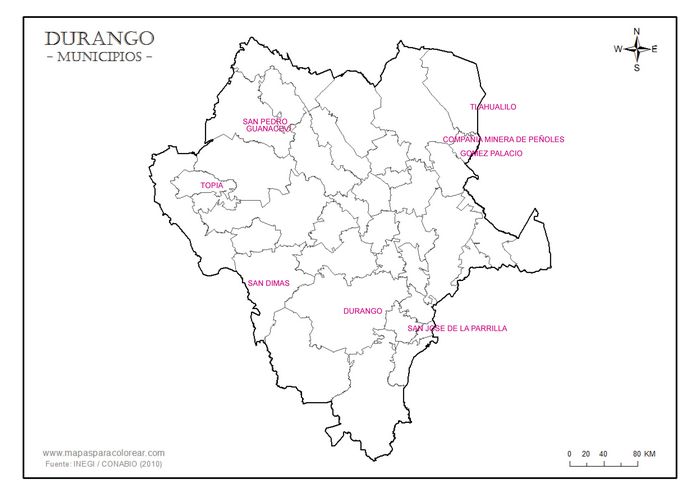 In the middle of 1913, because of the disruption in communications and the scarcity of small change, certain companies in Parral, Chihuahua and the surrounding area began to issue their own fractional paper currency. These valores de trabajo were payable to the bearer on presentation in the company's offices as soon as communications were restored (al portador una vez que se reanuden las comunicaciones, en sus oficinas de esta ciudad, á la presentación de esto).
In the middle of 1913, because of the disruption in communications and the scarcity of small change, certain companies in Parral, Chihuahua and the surrounding area began to issue their own fractional paper currency. These valores de trabajo were payable to the bearer on presentation in the company's offices as soon as communications were restored (al portador una vez que se reanuden las comunicaciones, en sus oficinas de esta ciudad, á la presentación de esto).
Many businesses and individuals were unwilling to accept some of these vales, and General Manuel Chao issued a circular[text needed] calling upon the issuers to formally request permission and to offer adequate guarantees. In consequence, on 22 September 1913 Chao issued a decree that people should accept the notes of the Compañía Ferrocarril Parral y Durango; the Alvarado Mining and Milling Company; the San Francisco del Oro Mining Company; the Concurso Mexico Consolidated Mining and Smelting Company; San Pedro, Guanaceví and E.T. Notts (sic), Guanaceví, and not accept the Fundicion de Fierro y Bronce, the El Rayo Mining and Development Company, the Mina La Cumbre y La Bufa or any other company that was not on the list of acceptable notesAMP, Tesorería, Tesorería, Correspondencia, caja 164, exp. 1.
On 5 October 1913 Villa, while at Torreón, decreed that the notes issued by the various companies in Chihuahua and Durango should be accepted as legal tender until such time as they were redeemed. He, for his part, would ensure that the companies honoured their paper¡Patria Libre!, Durango, 10 October 1913.
On 16 October Pastor Rouaix, discussing the notes that were circulating in the Comarca Lagunera, disposed that the only ones of obligatory circulation would be the bonos of the Asociación Durangueña, the bank-on-bank cheques, and those of the Compañía Jabonera de la Laguna, Compañía Algodonera e Industrial de la Laguna, and Ferrocarril eléctrico de Lerdo a Torreón, the other notes issued by businesses and individuals to be of voluntary circulationPeriódico Oficial, Durango, Tomo XXXVIII, Núm. 61, Durango, 6 November 1913.
In a decree of 15 December 1913 the commander in Durango, Coronel E. R. Nójera, listed the bonos that were of forced circulation in that state ¡Patria Libre!, Durango, 23 December 1913. These included some local bonos from Parral, Gómez Palacio and Torreón.
Once the Chihuahuan rebels issued their own currency, they quickly moved to stamp out other issues. On 23 December 1913 Villa ordered that the vales issued by certain Mexican and foreign-owned businesses (casas comerciales mexicanas y extranjeras) since the beginning of the revolution should be exchanged for revolutionary paper currency. However, in Parral they did not have the new currency and on 29 December General Luis Herrera, the Jefe de Armas, issued a circular that the vales should continue to be accepted. Local businesses were less willing and on 31 December formed themselves into a “Unión Mercantil” that demanded that the issuers give adequate guarantees to business and the public in generalAMP, Gobierno, Jefatura Política y Presidencia Municipal, Libros minutarios, 1913, AL12-13-000-102 letter to Presidente Municipal, 10 January 1913.
On 6 January 1914 the Presidente Municipal of Parral received copies of the notice that only sábanas and Constitucionalist issues were of forced circulationAMP, Gobierno, Jefatura Política y Presidencia Municipal, Libros minutarios, 1913, AL12-13-000-102 and on 12 January the Secretario de Gobierno told him to make sure that these companies did not issue any more vales. He therefore wrote to the various companies and to the printers in the city informing them of the edictibid.. On 23 January Governor Chao of Chihuahua set a deadline of 31 January for exchanging these irregular issues, though on 31 January the government extended the deadline: 5 February within the city of Chihuahua and 10 February outsidePeriódico Oficial, 1 February 1914. The notice refers specifically to mining scrip (vales de compañías mineras). Thereafter anyone in possession of such notes would be deemed a counterfeiter. Chao made a similar pronouncement in ParralEl Paso Morning Times, 2 February 1914.
On 4 February 1914 in Durango Secretario F. Rios Laurenzana told jefes políticos to order the withdrawal of prívate issues within fifteen days and produce a report detailing the issuers and amountsADUR, Fondo Secretaría General de Gobierno (Siglo XX), Sección 6 Gobierno, Serie 6.1 Acuerdos, caja 1, nombre 3. In Nombre de Dios Juan N. Orona, Francisco Flores A., Antonio Durán, Rodrigo and Librado Durán, José María Corona and Miguel Mercado denied making any such issuesADUR, Fondo Secretaría General de Gobierno (Siglo XX), Sección 6 Gobierno, Serie 6.1 Acuerdos, caja 1, nombre 3 report 9 February 1914 and on 18 February the jefe político replied that no issues had been madeADUR, Fondo Secretaría General de Gobierno (Siglo XX), Sección 6 Gobierno, Serie 6.1 Acuerdos, caja 1, nombre 3. On 8 February Nombre de Dios passed on the request to the Jefe de Policía in La Parrilla who reported that only Jesús María Galdívar and Eugenio Avila had issued notes to make up for the lack of change (boletas como contraseñas por la suma escases que hay de feria) in their grocery stores. The former had $3 and the latter $10 in circulation and both agreed to withdraw them in the next couple of daysADUR, Fondo Secretaría General de Gobierno (Siglo XX), Sección 6 Gobierno, Serie 6.1 Acuerdos, caja 1, nombre 3. In a telegram of 10 February Martín Martínez, the jefe político of Cuencamé, mentioned the Cia. Industrial Jabonera de la Laguna, S. A., Ferrocarril Eléctrico de Lerdo a Torreón, S. A.; Francisco Madero, Ferico (sic) Ritter, Guillermo Purcell y Cia, etc. etc. and was told that only the Ferrocarril Electrico were of forced circulationADUR, Fondo Secretaría General de Gobierno (Siglo XX), Sección 6 Gobierno, Serie 6.1 Acuerdos, caja 1, nombre 3. On 6 March the jefe político Interino of San Juan de Guadalupe, J. Y. Briones, reported that there were no mining companies in his jurisdictionADUR, Fondo Secretaría General de Gobierno (Siglo XX), Sección 6 Gobierno, Serie 6.1 Acuerdos, caja 1, nombre 3. H. Medina, the jefe político of Topia, passed the notification on to the following: the Negociación Minera Topia Mining Company, Plutarco C. Almeida, Albino Rico, Ramón Camarena and Rómulo Gamboa. Clemente Corrales, the temporary manager (gerente interino) of the Topia Mining Company, replied that they had issued $5,412.30 in “Vales al Portador”or “Comprobaciones”, which were accepted by all businesses and exchanged monthly for cheques drawn on Culiacán. The others did not know how much they had issued since they had suspended their own boletas about two months before, that is, when the Topia Mining Company issued its vales. The government agreed to send enough money for the Topia Mining Company to redeem its notesADUR, Fondo Secretaría General de Gobierno (Siglo XX), Sección 6 Gobierno, Serie 6.1 Acuerdos, caja 1, nombre 3 report, 4 March 1914.
On 12 February Silvestre Terrazas, the Secretario de Gobierno in Chihuahua, wrote to Tomás Lizárraga D., the Administrador Principal del Timbre, in Parral, thanking him for the details that he had sent about the vales in that district. It was planned to exchange them for Chihuahua money, but they did not yet have enough notes. In the meantime Terrazas instructed the Presidente Municipal to acknowledge (haga efectivos) the vales he listed with the exception of banks that did not have any branches in the state and the Concurso México Consolidated Mining and Smelting Company, who had already agreed to back their notes with their bullionST papers.Part I, box 84. The same day Terrazas told the Presidente Municipal to ensure that the companies redeemed immediately, in silver or on cheques drawn on a Chihuahua or foreign bankAMP, Gobierno, Jefatura Política y Presidencia Municipal, Libros minutarios, 1913, AL12-13-000-102. Presumably paying the Tesorería rather than individual holders..
Thus, the vales in Parral were gradually redeemed, although it took some time because of a delay in receiving sufficient of the new sábanas with which to replace them. It was also not without difficulties: when the Tesorero Municipal heard that the Recaudación de Rentas had received funds to make the exchange, it sent over $1,000 in vales, but the Recaudación only accepted $500, claiming that the rest were too well used, and the Administración del Timbre refused to accept other vales with which the Tesorería tried to pay its taxesAMP, Gobierno, Jefatura Política y Presidencia Municipal, Correspondencia, caja 69, exp 1 report of Tesorero Municipal, 18 February 1914. On 5 March the “Unión Mercantil” was still complainingAMP, Gobierno, Jefatura Política y Presidencia Municipal, Correspondencia, caja 69, exp 1.
Compañía del Ferrocarril Parral y Durango (Parral y Durango Rail Road Company)
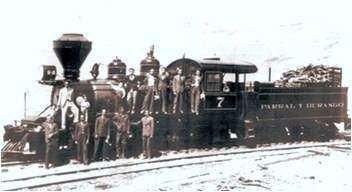
The Parral y Durango Rail Road Company was incorporated in Colorado in 1898 and owned the line from Minas Nuevas, Chihuahua to Paraje Seco, Durango, built under a concession granted on 29 June 1898. From Rincón it had a narrow gauge branch line to Parral, which connected with the Parral branch of the Mexican Central Railroad.
This company made an issue[images needed] in 1913 to pay its workers because of the shortage of banknotes, though its representative thought that the total amount was very insignificant, and might have made another issue in 1916. The notes were signed either by R. J. Long, the general manager, or by J. Reno Wilson. Unfortunately, the company’s records were reduced to ashes in one of the Villista raidsAMP, Gobierno, Jefatura Política y Presidencia Municipal, Actas, caja 23, exp 19 evidence of Manual Cortés.
| R. J. Long was brother of James I. Long, the general manger of the Hidalgo Mining Company and American consul in Parral. By 1908 he was general superintendent of the Hidalgo Mining Company and assistant general manager of this railway companyThe Mexican Herald, Vol. XXVI, No. 69, 8 May 1908, becoming general manager by September 1911. | |
| J. Reno Wilson |
Topia
Negociación Minera Topia Mining Company
As stated above the Topia Mining Company issued $5,412.30 in “Vales al Portador”[images needed], which were accepted by all businesses and exchanged monthly for cheques drawn on CuliacánADUR, Fondo Secretaría General de Gobierno (Siglo XX), Sección 6 Gobierno, Serie 6.1 Acuerdos, caja 1, nombre 3 report, 4 March 1914.
| from | to | total number |
total value |
||
| $ 5,412.30 |
Plutarco C. Almeida
In 1908 Plutarco C. Almeida was a vocal suplente of the Topia town councilAnuario Estadístico del Estado de Durango, 1908. In 1908 he registered the Guadalupe del Bajo silver and lead mine in TamazulaDiario Oficial, 22 January 1908 and the Angel silver and lead mine in TopiaDiario Oficial, 16 March 1908 but the latter had failed by 1911Diario Oficial, 24 January 1911.
The revolutionaries besiged Topia on 27 February 1911 and the town surrendered on 11 March. The next month Almeida, together with other businessmen (Estanislao Torres, B. Almeira, José Castillo y Hnos., Ramón Camarena, Apolonio Espino, Luciano Fragoso, V. Herrera, and Albino Rico) complained to the jefe politico that they had agreed a ceasefire with the Maderistas who took over the town and wanted the jefe politico to reach some agreement to avoid bloodshed and hungerEl Tiempo, Año XXVIII, Núm. 9,128, 7 April 1911.
Almeida had issued boletas but had withdrawn them by January 1914.
After the Revolution Almeida was Recaudador de Rentas in TamazulaPeriódico Oficial, 24 December 1931.
Albino Rico
Albino Rico was another signatory of the letter to the jefe políticoEl Tiempo, Año XXVIII, Núm. 9,128, 7 April 1911. He had also issued boletas but had withdrawn them by January 1914.
Ramón Camarena
Ramón Camarena owned the María Luisa mine. He was síndico of the Topia town council for 1908Anuario Estadístico del Estado de Durango, 1908. He was another signatory of the letter to the jefe políticoEl Tiempo, Año XXVIII, Núm. 9,128, 7 April 1911.
Rómulo Gamboa
When the Orozquistas took Topia in 1912 they demanded $5,000 from Rómulo Gamboa Rios and threatened to kill him if he did not pay but settled for $500 as the Federals were approachingEl Criterio, Tomo II, Núm. 41, 21 April 1912.
Gamboa had issued boletas but had withdrawn them by January 1914.
A Rómulo Gamboa served in the 1920-1922 state legislature. Gamboa died in Gómez Palacio in 1957.
San Pedro
Concurso México Consolidated Mining and Smelting Company
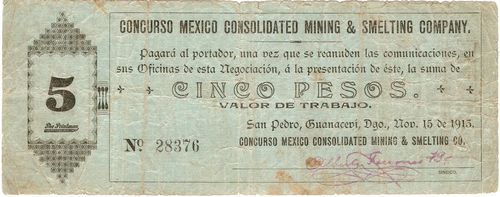
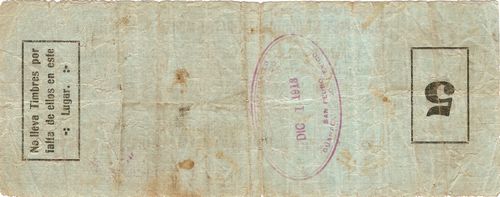 M1571 $5 Concurso México Consolidated Mining and Smelting Company
M1571 $5 Concurso México Consolidated Mining and Smelting Company
| from | to | total number |
total value |
||
| $5 | includes number 28376 |
Although geographically in Durango, Guanaceví had close ties with Parral. The Concurso México Consolidated Mining and Smelting Company issued a $5 note, printed by the Printman printing company dated 15 November 1913.
A notice dated 26 December 1913 stated that henceforth the company’s vales would not be accepted in public offices and their circulation was prohibited as the company was apparently insolvent, but by 31 December it had give adequate security to the Chihuahua state government and the Presidencia Municipal was told that it could receive and exchange this moneyAMP, Tesorería, Tesorería, Correspondencia, caja 165, exp. 1 telegarm from Silvestre Terrazas, Secretario de Gobierno, 31 December 1913. On 3 January 1914 the Presidente Municipal asked holders of these Concurso vales to report on Wednesday, 7 January, between 9 a.m. and 1 p.m. or from 3 p.m. to 5 p.m. so that he knew how many notes were outstanding and how much he needed to ask for to be able to exchange themAMP, Gobierno, Jefatura Política y Presidencia Municipal, Libros minutarios, 1913, AL12-13-000-102.
On 17 January J. Y. Briones, the jefe municipal of Guanaceví reported that the amount issued by the Concurso to date was $153,000ADUR, Libro Copiador 267, Hacienda 11 July 1913 - 25 April 1914, p697.
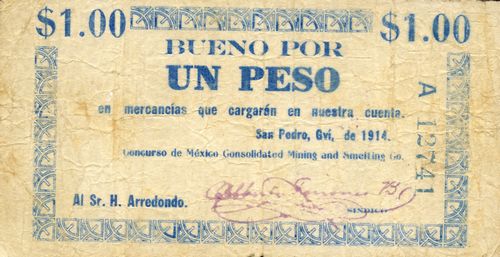
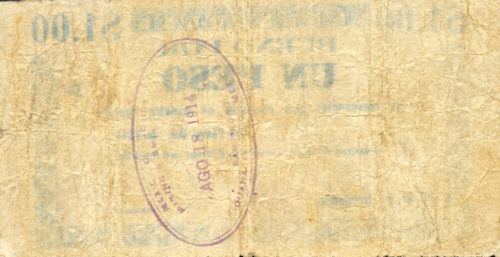
M1570 $5 Concurso de México Consolidated Mining and Smelting Company
| series | from | to | total number |
total value |
||
| $1 | A | includes number 12741 |
The company later issued $1 cheques, addressed to H. Arrendondo, good for merchandise to be debited to the company's account. One is handstamped with the date 18 August 1914.
Both these notes are signed by the cajero of the company, Alberto Terrones Benitez.
|
He moved to Guanaceví and worked for the Consolidated Mining & Smelting Company. He worked as an attorney for foreign mining companies doing business in Durango during the most violent years of the Mexican Revolution, sometimes managing his clients' affairs from the relative security of offices in El Paso, Texas. In December 1915 he was detained on the orders of General Francisco Murguia but his supporters claimed that he was not a Villista and had stayed in Guanaceví merely for professional reasonsADUR, Fondo Secretaría General de Gobierno, Sección Siglo XIX, Serie Correspondencia, Subserie Revolución, gaveta 7, nombre 38. By March 1916 the U.S. State Department was pressing for his releaseADUR. Fondo Secretaría General de Gobierno, Sección Siglo XIX, Serie Correspondencia, Subserie Revolución, gaveta 7, nombre 38. Because of his revolutionary credentials he took part in the Constitutional Congress in Querétaro in 1917, as a deputy from Tepehuanes, Durango. He reincarnated himself as an agrarian reformer, to emerge by 1925 as the principal organizer of government-sponsored campesino organizations in Durango. The fortuitous, simultaneous elimination of local leaders like José María Carreón Rodríguez and radical ideologues like José Guadalupe Rodríguez left agrarianism in Durango exclusively in the hands of government functionaries like Terrones Benítez, who not coincidentally was the founder of the Partido Nacional Revolucionario in Durango in 1929. “To some extent, then, the dramatic agrarian reforms of the Cardenas regime later in the 1930s were redundant or even irrelevant in Durango, where a state-level corporatist structure of political control, based on government-sponsored rural organizations and official agrarian reform, had already emerged as the final waste product of a spent agrarian revolution.” Terrones Benítez served as interim governor of Durango from March 1929 to September 1930, president of the Tribunal Superior de Justicia of Durango, a federal deputy and a senator for Durango. He died in Mexico City on 28 December 1891 at the age of 94. |
 |
The Mexico Consolidated Mining and Smelting Company managed to continue operations, although on a smaller scale, until October 1914 when it was compelled to shut down after a very serious accident at the El Tule property, which caused all the water of an overflow to dash into all the minesThe Mexican Herald, 20th Year, No. 6,992, 29 October 1914.
Guanaceví
E. F. Knotts
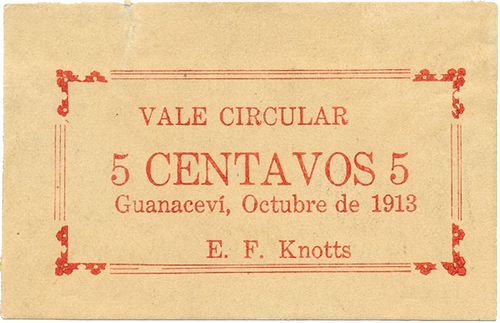
M1550 5c E. F. Knotts
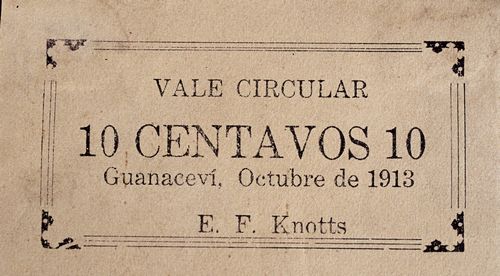
M1550 10c E. F. Knotts
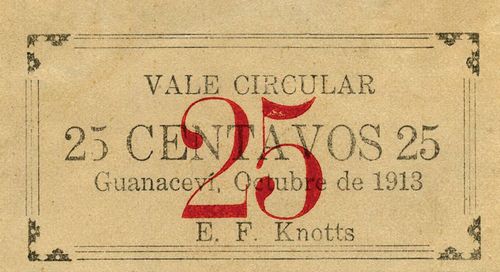
M1552 25c E. F. Knotts
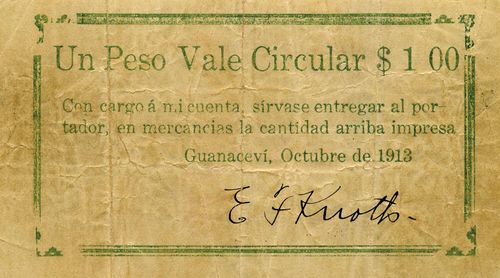
M1554 $1 E. F. Knotts
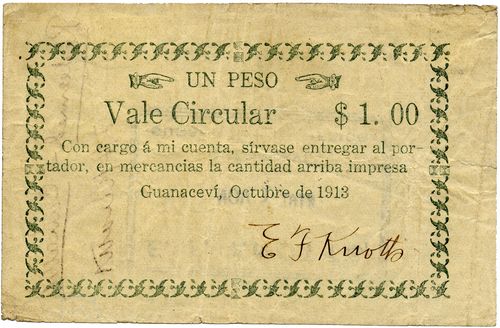
M1553 $1 E. F. Knotts
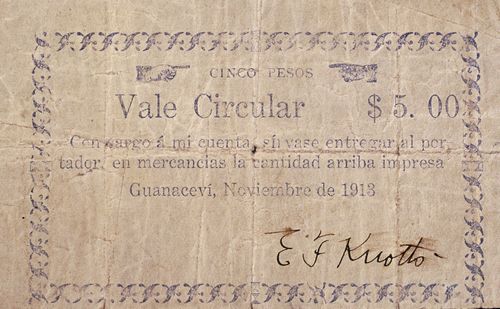
M1555 $5 E. F. Knotts
Hacienda de Anita
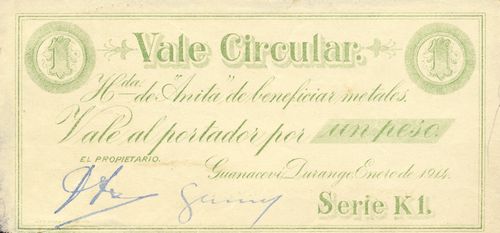
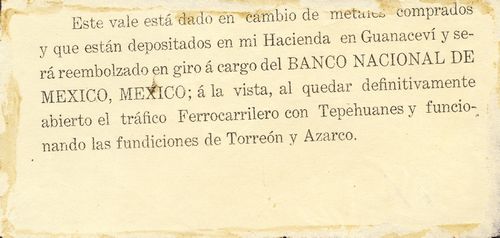
M1547 $1 Hacienda de "Anita"
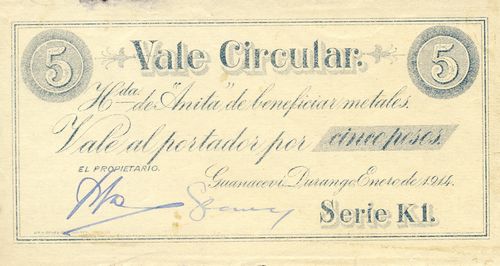
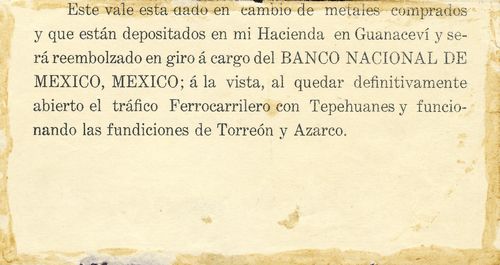
M1548 $5 Hacienda de "Anita"
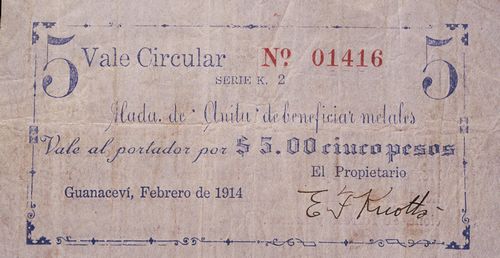
M1549 $5 Hacienda de "Anita"
| date on note | series | to | from | total number |
total value |
||
| $1 | January 1914 | K1 | unnumbered | ||||
| $5 | January 1914 | K1 | unnumbered | ||||
| February 1914 | K2 | includes number 01416 | |||||
E. F. Knotts was the signatory on a series of vales, (5c, 10c, 25c, $1 (two types) and $5) dated October and November 1913 and also the signatory as proprietor on a $5 vale issued by the smelter Hacienda de Anita, Guanaceví in February 1914. The Hacienda de Anita also issued $1 and $5 vales dated January 1914, given out in exchange for metal bought by the hacienda and redeemable when communications were resumed and the smelters at Torreón or Chihuahua functioning.
|
He spent most of his life as a miner. By August 1902 he was secretary of the Compañía Minera de Santa Cruz y Anexas of GuanacevíThe Mexican Herald, Vol. XV, No. 343, 12 August 1902. By 1911 he was the successful operator of the Anita custom millA custom mill milled and treated the ore of “gambustinos” and small sellers that scratched the ore of some mines in the camp (The Mexican Herald, 29 October 1914), and developing the Tecolotes and other minesThe Mexican Herald, vol. XXXI, no. 142, 19 February 1911. He wrote a short story, "Prisoner of Pancho Villa" about his experiences with Francisco Villa. Villa held him for a ransom of $25,000 in gold. They became friends and after he was released from being a prisoner, Frank requested and relied on Villa's support in making sure payroll got to his Mexican miners on time. He died about 14 June 1934 in El Paso, Texasimage and biographical details courtesy of Joe Knotts. |
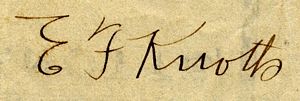 |
Jefatura Municipal
The Tesoreria Municipal in Parral distinguished Concurso vales from Guanaceví vales as on 9 March 1914 it reported that it had $354.00 of the former and $93.75 of the latterAMP, Gobierno, Jefatura Política y Presidencia Municipal, Correspondencia, caja 69, exp 1. The latter were probably vales issued by the Jefatura Municipal of Guanaceví. We know of two different types of $1 notes issued in December 1913.
 M1526 $1 Jefatura Municipal
M1526 $1 Jefatura Municipal
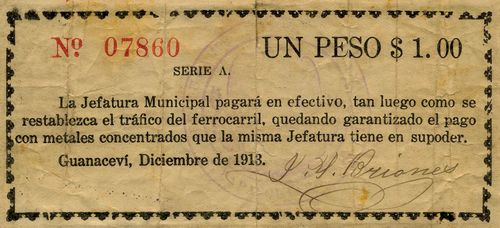 M1525 $1 Jefatura Municipal
M1525 $1 Jefatura Municipal
| date on note | series | from | to | total number |
total value |
||
| $1 | December 1913 | A | includes numbers 05742 to 06436 | ||||
| December 1913 | A | includes numbers 07442 to 07860 | |||||
| 3,904 | $ 3,904 |
| J. Y. Briones |  |
On 7 January 1914 the Presidente Municipal of San Isidro de las Cuevas reported that to date people had presented $2,200 in Guanacevi vales and he expected the figure to rise to $2,500AMP, Gobierno, Jefatura Política y Presidencia Municipal, Correspondencia, caja 69, exp 1.
On 22 January J. Y. Briones, the jefe municipal of Guanaceví reported that his Jefatura has issued 3,904 $1 vales ‘garantizado con metales concentrados que tiene en su poder y que espulsamente ensayados y deduciendo misma fletes maquina producirán la cantidad necesaria para el pago’ADUR, Fondo Secretaria General de Gobierno (Siglo XX), Sección 6 Gobierno, Serie 6.7 Correspondencia, caja 7, nombre 12.
Over a year later, on 23 July 1915, Dionosio Ruiz and other businesses in Guanaceví asked the governor to allow the local Jefatura to print a quantity of 5c, 10c, 25c and 50c vales, guaranteed by a deposit of Durango or Chihuahua notes, to overcome the dire troubles caused by the shortage of small change. Instead, the governor told the Dirección General de Rentas to send the local Subrecaudación de Contribuciones $2,000 in fractional currencyADUR, Fondo Secretaría General de Gobierno, Sección Siglo XIX, Serie Correspondencia, Subserie Revolución, gaveta 7, nombre 15 and ADUR, Libro Copiador 304, Hacienda 20 May 1915 - 1 March 1916, p352, p354 and p355.

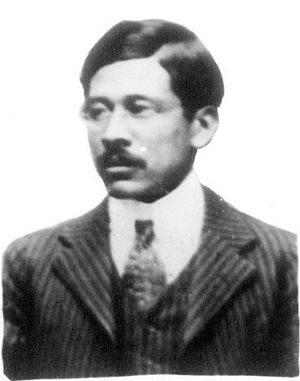 Alberto Terrones Benitez was born in Nombre de Dios on 3 July 1887. He graduated in law and also studied economics, specialising in mining law and economics.
Alberto Terrones Benitez was born in Nombre de Dios on 3 July 1887. He graduated in law and also studied economics, specialising in mining law and economics.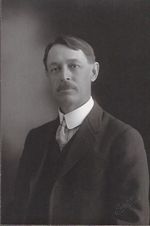 Elijah Franklin Knotts was the son of Joseph Lemuel Knotts, who moved to Mexico from Iowa to operate silver mines and in 1876 was appointed the U. S. consul at Chihuahua. Elijah was born on 4 October 1867 in Council Bluffs, Pottawattamie, Iowa and came to Mexico with his parents.
Elijah Franklin Knotts was the son of Joseph Lemuel Knotts, who moved to Mexico from Iowa to operate silver mines and in 1876 was appointed the U. S. consul at Chihuahua. Elijah was born on 4 October 1867 in Council Bluffs, Pottawattamie, Iowa and came to Mexico with his parents.